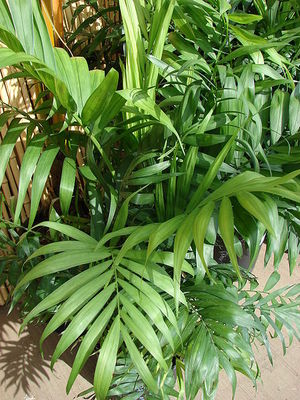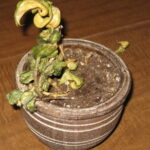Palm trees are one of the most popular of all tropical plants to grow indoors. The Victorians grew them in the parlors of their homes in the early 1900’s, and we’re carrying on the tradition today. Few indoor houseplants bring images of the tropics to mind quite the way a palm tree does.
Thousands of species of palm trees exist, but only a small percentage are used as houseplants. One such palm tree includes the parlor palm (Chamaedorea elegans) made popular during the Victorian era. Once you know how to care for an indoor palm tree, it can survive and even thrive in homes and offices, no parlor required.
Palm trees need warm temperatures, since most are native to tropical or subtropical regions of the world. But warmth doesn’t always translate to full sun. Since many palms are understory trees that need shade from taller palm trees, this enables some palm species to survive the low light conditions typical of most interiors.
Bright indirect light during the spring and summer months is usually enough to keep most indoor palm trees growing happily. But a sunny window is fine for the winter months, when days are shorter and light intensity decreases.
Humidity is essential for growing palms indoors. Dry air can wreak havoc on palm trees. I worked for many years in the tropical plant industry, and this was always the main reason for unhealthy palm trees. Spider mites are tiny insects that thrive and multiply when the air lacks humidity. Mites suck the juices from the leaves and eventually weaken or kill the palm tree.
One simple way to increase humidity is by grouping houseplants together. It’s not only healthy for plants, but it’s attractive when plants are grouped as a collection. The humidity is increased because plants drink water through the roots, the leaves transpire and release moisture back in the air. So if you’re a collector like me, group those potted plants around the palm tree at staggered heights for visual interest and to raise the humidity level near the palm. Another option is to grow vines in the same planter with the palm tree. An easy-to-grow vine choice is pothos (Epipremnum aureum.)
Once the heat comes on in the winter, especially natural gas heat, you’ve got to step up your effort to increase humidity. The least expensive method is to place containers of water in the room and allow the water to evaporate. Other alternatives include electric humidifiers or small indoor water fountains placed near the palm tree. Also keep a spray bottle filled with water and spritz the leaves often to keep the leaves moist, although it only raises the humidity briefly.
Water requirements for indoor palm trees are fairly simple. Water when the top of the soil feels dry to the touch. Then give a thorough soaking until water runs from the drain holes. Never leave a plant sitting in soggy soil for long periods, especially in low light conditions. More indoor plants are killed during winter’s low light conditions from over-watering, than from too little water.
Use a balanced 20-20-20 fertilizer to feed the palm tree. My favorite is the water soluble “blue stuff” that’s been popular with horticulturists longer than I’ve grown houseplants. Follow the directions on the package for mixing the fertilizer. There are two methods for using it. One method uses a extra mild solution fed to the plant each time the tree is watered. The second method uses a stronger solution of fertilizer, but much less often. The package will give directions for both solutions.
Check frequently for insects, especially spider mites. The palm fronds need to be cleaned regularly with a damp cloth or paper towel, so use this time to check for insects. Occasionally replace damp dusting with a lukewarm shower. Showers help wash away any spider mites that are present, and greatly decrease the need for insecticides.
Don’t place the palm tree near heaters or cold drafts in the winter or air conditioning vents in the summer months. Try to place the tree in a location where the fronds won’t be brushed against regularly. The fronds become damaged and the only remedy is removing the entire frond.
Source: I worked in the horticulture industry for 15 years and have extensive experience with tropical houseplants.





